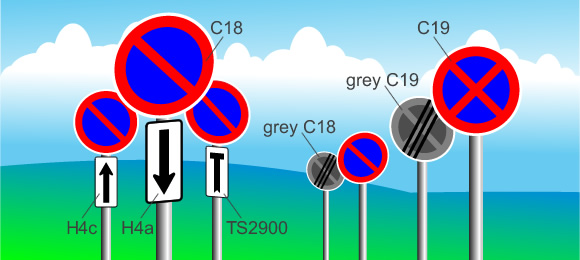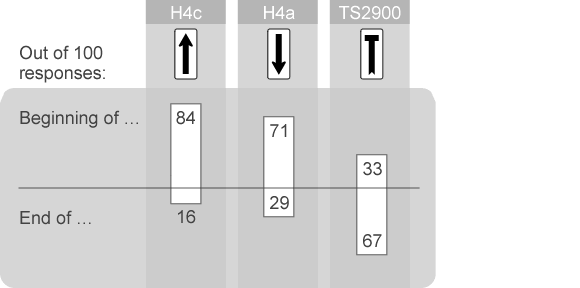
During the review of the 1968 Convention on Road Signs and Signals by the United Nation’s “Expert Group on Road Signs and Signals” in May 2017, it became obvious to me that the current use of arrows in additional panels H4a and H4c, meant to convey “beginning –” and “End of a parking prohibition” is ambiguous and may not be comprehended well by road users.
For clarification, a study consisting of three short online surveys was conducted (3 x 100 persons from 19 to 35 countries). Results were unexpectedly straight forward:
Study on “Beginning –” and “End of a parking prohibition” confirms ambiguity of current practice and provides a solution.
Both the upward pointing arrow of additional panel H4c and the downward pointing arrow of H4a are considered as meaning “Beginning of a parking prohibition” (H4c at 84 %, H4a at 71 %), but H4c to a higher degree. Accordingly, none of these arrows do convey the message of “End of parking prohibition” sufficiently.

Reasons for this might lie in the fact that H4a and H4c contradict with the general use of upward and downward pointing arrows in the 1968 Convention, which is not laid down in writing, but becomes obvious when investigating all road signs depicted: The upward pointing arrow is used to indicate a meaning as “onward from here” or “ahead”, but never “backward” or “behind”. H4a and H4c are the only exceptions, opposing this paradigm.
Since there is no symbol to adequately convey “End of …”, it seems obvious that a proposal stemming from common use of the 1968 Convention would suffice: Symbol TS2900 proved to be understood as intended. Scoring at 67 %, it outperformed H4a by 38 %, and H4c by 51 %.
Considering the results, the upward pointing arrow of H4c should be used in conformity with the Convention, to mean “Beginning of a parking prohibition” while TS2900 should convey “End of …”. The downward pointing arrow should not be used. Find more detailed information on the survey in the report: BeginEndParking_s-egger (PDF, 0,6 MB)
TS2900 is available here: Tern Symbol TS2900
A solution without the need for additional panels
Although the results of the study are clear, consideration should be put into another common use of the Convention, which allows to convey “End of …” without the need of additional panels, foreseen for prohibition and restriction signs (Section C and also E). To constitute an “End of …” C signs are “greyed out” and overlayed by a black “End-of band”
So without the need for additional panels, parking prohibition sign C18 (and C19), set perpendicular to the direction of road, would signal the beginning of the prohibition, while a grey C18 (and grey C19), overlayed by a black band would end the prohibition.

It is advised to introduce signs refered to here as “grey C18” and “grey C19” to the Convention. The reduction of additional panels no longer needed implies reduction of costs and reduced visual clutter.
Information on the common use of arrows in the Convention, the study, the reasoning behind the development of TS2900 and the introduction of “grey C18 and 19” is to be found in this presentation on Slideshare: https://www.slideshare.net/ICICfp7/low-understanding-of-beginning-and-end-of-parking-prohibition-and-solutions
Pingback: Road signs parking prohibition: Current ambiguous use of arrows, and 2 solutions | Stefan Egger
For the Colombian manual we combined the arrow and restriction in one rectangular sign with the round No Parking symbol with a an upward arrow and the word BEGIN or downward arrow with the word END to indicate the beginning and end of the no park zone.
Of course, you can also use a pavement marking or curb marking to clarify the situation.